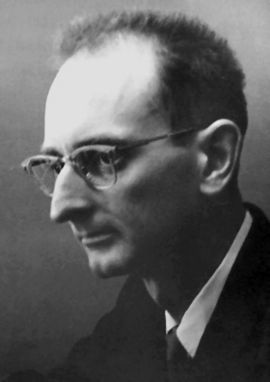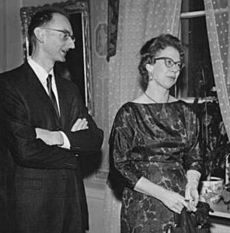Owen Chamberlain facts for kids
Quick facts for kids
Owen Chamberlain
|
|
|---|---|

Chamberlain in 1959
|
|
| Born | July 10, 1920 |
| Died | February 28, 2006 (aged 85) Berkeley, California, U.S.
|
| Alma mater | Dartmouth College University of California, Berkeley University of Chicago |
| Known for | Particle physics |
| Awards | Nobel Prize in Physics, 1959 |
| Scientific career | |
| Fields | Physics |
| Institutions | Los Alamos National Laboratory |
| Doctoral advisor | Enrico Fermi |
| Doctoral students | Paul Grannis, Nathan Isgur |
Owen Chamberlain (born July 10, 1920, died February 28, 2006) was an American scientist who studied physics. He is famous for discovering the antiproton with his colleague, Emilio Segrè. An antiproton is a tiny particle, like a proton, but with an opposite electrical charge. For this important discovery, they both won the Nobel Prize in Physics in 1959.
Contents
Early Life and Education
Owen Chamberlain was born in San Francisco, California. He finished high school in Philadelphia in 1937. After that, he went to Dartmouth College and the University of California, Berkeley to study physics.
His studies were interrupted when World War II began. In 1942, he joined the Manhattan Project. This was a secret project to build the first atomic bomb. He worked with Emilio Segrè at both Berkeley and Los Alamos, New Mexico. In 1943, he married Beatrice Babette Copper, and they had four children.
Becoming a Physicist
After the war ended in 1946, Chamberlain continued his studies at the University of Chicago. His teacher and mentor was the famous physicist Enrico Fermi. Fermi encouraged Chamberlain to focus on experimental physics. This type of physics involves doing experiments to test ideas, rather than just thinking about them. Chamberlain was very good at this. He earned his Ph.D. from the University of Chicago in 1949.
Discovering the Antiproton
In 1948, Owen Chamberlain returned to Berkeley to work as a professor. There, he and Emilio Segrè, along with other scientists, studied how protons interact.
In 1955, they used a large machine called the Bevatron at Berkeley. They did a series of experiments that led to a huge discovery: the antiproton. This particle is like a proton, but it has a negative electrical charge instead of a positive one. This was a big step in understanding the tiny building blocks of the universe.
Chamberlain continued his research after this discovery. He worked on other projects, including the time projection chamber (TPC). He also did research at the Stanford Linear Accelerator Center (SLAC).
Activism and Later Life
Owen Chamberlain was also very involved in issues of peace and fairness. He spoke out against the Vietnam War. He was part of a group called Scientists for Sakharov, Orlov, and Shcharansky. These were three physicists from the former Soviet Union who were put in prison for their political beliefs.
In the 1980s, he helped start the nuclear freeze movement. This movement wanted to stop the production of more nuclear weapons. In 2003, he was one of 22 Nobel Prize winners who signed the Humanist Manifesto. This document shares ideas about human values and ethics.
Chamberlain was diagnosed with Parkinson's disease in 1985. He stopped teaching in 1989. He passed away on February 28, 2006, in Berkeley, at the age of 85, due to problems from his illness.
See also
 In Spanish: Owen Chamberlain para niños
In Spanish: Owen Chamberlain para niños


